The winner – Omnisend
Life-changing superhero
In this comparison, Omnisend wins nine out of eleven rounds. One round ends in a tie, and there is only one aspect where MailPoet outperforms Omnisend. Continue reading to learn more.
What Omnisend features are better than MailPoet?
- Email building features, email templates and the Campaign Booster
- Advanced marketing automation
- Immediate customer support 24/7 for all customers
- Good campaign and signup form analytics
- Email+SMS campaigns worldwide
- Email editor contains only standard email content blocks
- Less email templates
- There is no A/B testing
- Basic marketing automation
- No landing pages and form analytics
- Slow customer support
MailPoet and Omnisend are among the top options when choosing an email marketing platform on WordPress.
MailPoet was founded in 2011 and targets business website owners. Meanwhile, Omnisend began operations in 2014 with its services targeted at ecommerce marketers.
Both platforms offer valuable features and templates to create stunning emails. However, there are some key differences to consider.
For example, MailPoet has an easy-to-use design. Whereas Omnisend prides itself on its powerful marketing automation capabilities and robust features.
Even so, which tool performs better?
This MailPoet vs Omnisend comparison provides an unbiased review of the two platforms. By the end of this post, you’ll understand which tool best meets your business needs.
MailPoet vs Omnisend: Quick overview
MailPoet and Omnisend are strong players in the email marketing industry. Both platforms have built a solid customer base.
More than 700,000 WordPress websites have downloaded the MailPoet plugin (4.5/5 stars).
Omnisend, on the other hand, has an impressive 4.8-star Shopify rating based on over 5,300 reviews and a solid 5-star review on the WordPress Plugin library (so far, 100+ reviews). Businesses appreciate Omnisend’s email automation, segmentation, customizable templates, and top-notch customer support.
In this section, we’ll examine the key features of MailPoet and Omnisend. Our comparison will help you determine the most suitable tool for your needs.
The table above shows that MailPoet and Omnisend offer comparable features. However, Omnisend excels in providing advanced features and generative AI tools.
MailPoet vs Omnisend comparison: Feature by feature
Both MailPoet and Omnisend cater to distinct needs. This section details a feature-by-feature analysis of both tools to help you decide which best suits your business. We’ll also provide our verdict on which platform leads in each category.
Ease of getting started
Both Omnisend and MailPoet have a smooth signup process. The tools make it easy for beginners to get started with email marketing.
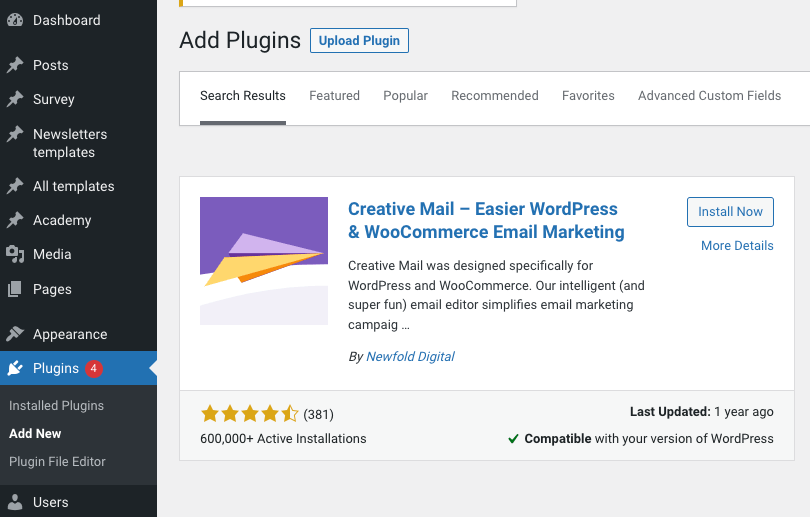
You have to download plugins to start using email marketing. The only thing that differs is the interface. MailPoet is functioning in the WordPress system, and Omnisend is a stand-alone platform, so when clicking on the plugin, you will be brought to a separate platform with all the necessary features related to your email marketing activities.
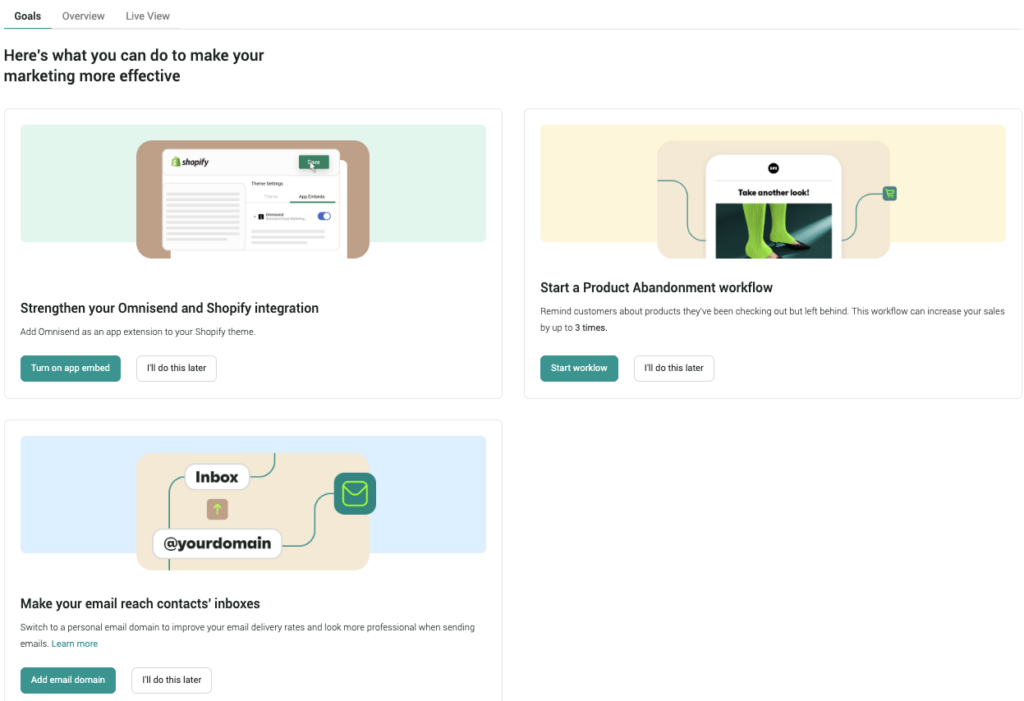 Whether you choose MailPoet or Omnisend, you can register for the free plan without inputting your credit card details.
Whether you choose MailPoet or Omnisend, you can register for the free plan without inputting your credit card details.
The two platforms make it easy to find and customize the settings, even for beginners. Both tools have a clean interface with menus and buttons for navigation.
It’s a draw. Both platforms offer a clear and standardized signup process.
Building an email campaign
MailPoet and Omnisend have intuitive email builders with a clear email campaign wizard. With this, you can name your campaign, add recipients, and customize your content.

MailPoet Email editor
MailPoet offers standard email builder functions: images, texts and other standard elements. Its paid plans have a unique feature – a dynamic content block. These allow you to include information from your blog in your emails automatically.
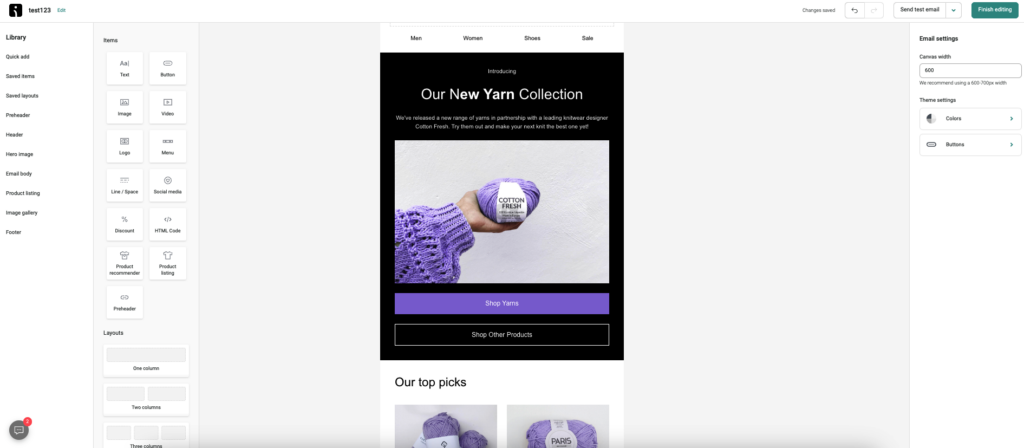
Omnisend Email editor
As for Omnisend, there are multiple formatting options with an inbox preview feature. This feature lets you preview your email’s appearance on both desktop and mobile devices.
Omnisend also has a Product Picker feature and a product formatting option for all users. The Product Picker lets you pull product images and descriptions directly from the store. With the formatting option, you can align product images better with the email design.
MailPoet has 50+ basic but decent templates. Omnisend, on the other hand, boasts over 250 modern templates across many themes. You can also customize them to incorporate the brand assets automatically.
In terms of email types, MailPoet offers regular newsletters and automation campaigns. However, Omnisend goes beyond these to offer other email types, such as:
- Regular newsletters
- A/B test email campaigns
- Multiple marketing automation campaigns, including cart abandonment, welcome, etc.
- Email+SMS campaigns
For email personalization, MailPoet uses merge tags. These help personalize the content of your emails.
In contrast, Omnisend offers more personalization options. These include merge tags in the subject lines, preheaders, and email copy; dynamic Product Recommender.
Omnisend emerges as the winner for this round. It has a robust email builder with unique features. This includes the inbox preview feature, the Product Picker, and the Product Recommender.
Marketing automation
Marketing automation is an essential feature of any email marketing solution. With MailPoet, you can create and send automated email campaigns. It initiates these campaigns in response to specific, predetermined triggers and conditions.
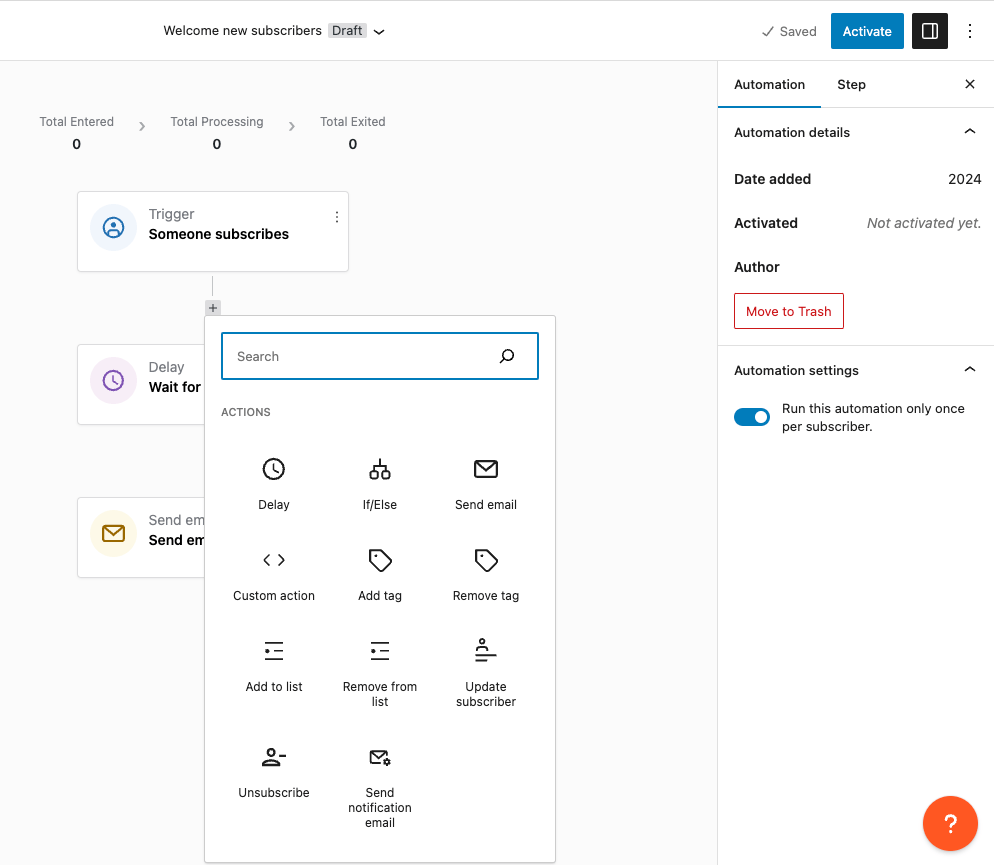
MailPoet automation
Same Omnisend. In addition, Omnisend allows A/B testing to test different variations of your emails, whereas MailPoet doesn’t.
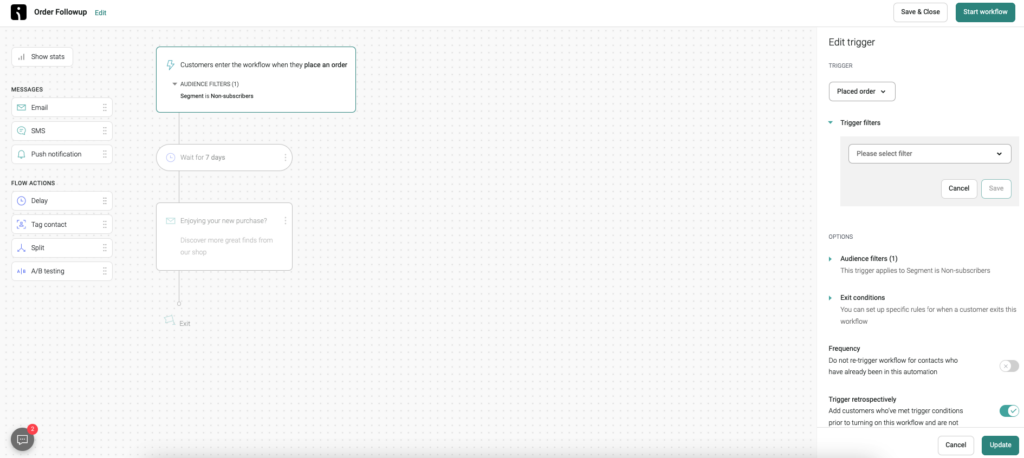
Omnisend automation
Both platforms offer prebuilt, ready-to-go workflows. With MailPoet, the automation templates are mainly for welcoming new subscribers and re-engagement emails.
Conversely, Omnisend has 30 prebuilt and customizable automation workflows. With just a few steps, you can launch them.
These ready-to-use workflows include the following:
- Product reviews
- Browse abandonment
- Replenishment reminder
- Welcome series
- Back in stock
- Customer reactivation
- Order confirmation
- Cross-sell
- Order follow-up
Regarding integration with other marketing channels, MailPoet only uses email. Whereas Omnisend integrates SMS and push notifications into its automation workflows.
Omnisend takes the lead in marketing automation. Omnisend offers advanced functionalities. This includes A/B testing, more prebuilt workflows, and integration with other marketing channels.
Signup forms and landing pages
Regarding signup forms and landing pages, which platform takes the lead, Omnisend or MailPoet?
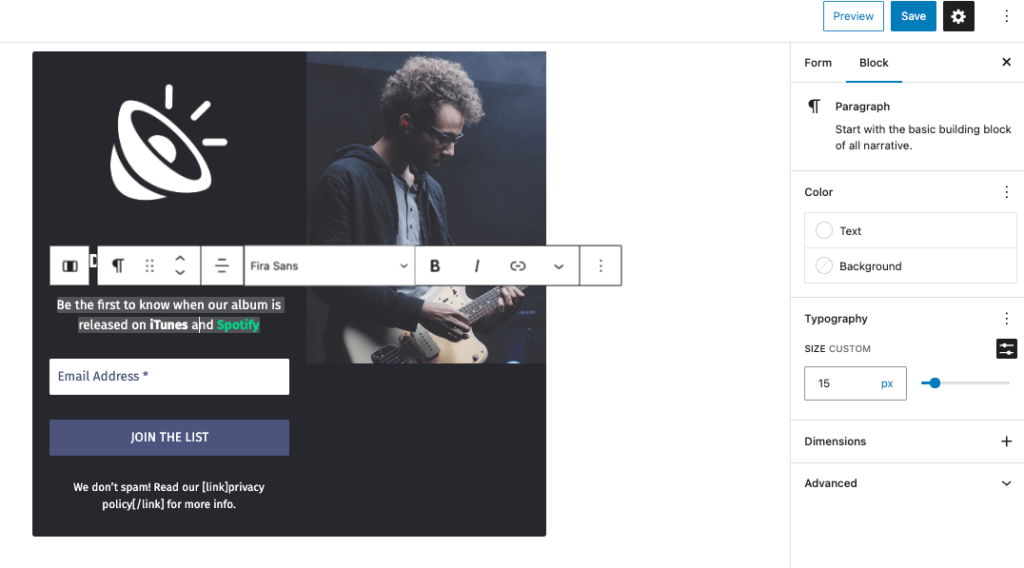
MailPoet form editor
MailPoet provides basic form-building tools. You can create five different signup forms, each with ten designs. These form types include popups, below pages, widgets, slide-ins, and fixed bars.
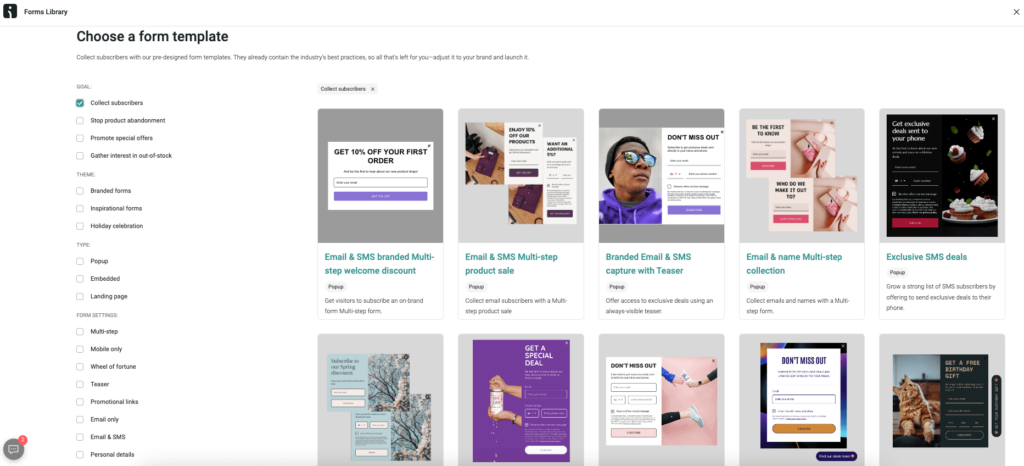
Omnisend Signup form library
Omnisend, on the other hand, has 100+ modern-looking signup forms and landing page designs. You can easily customize them to suit your brand’s color and style.
Some of these form and landing page designs include:
- Embedded form
- Teaser
- Multistep popup
- Gamified wheel of fortune
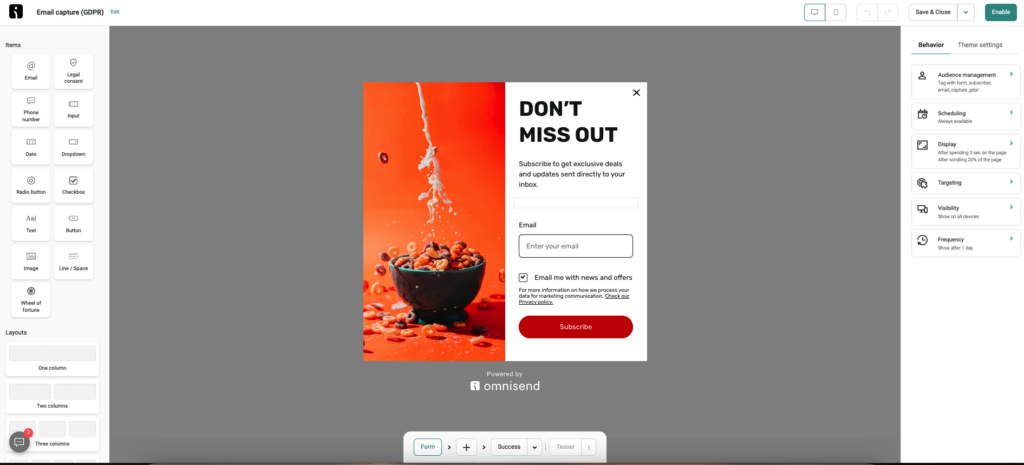
Omnisend Signup form editor
Omnisend offers eight ready-to-use landing pages. It also has a wizard that allows you to create custom landing pages. Although Omnisend doesn’t offer landing pages with a checkout function, MailPoet doesn’t have landing pages at all.
Additionally, Omnisend’s analytics tool allows you to monitor the performance of your signup form based on metrics including:
- Actual signups
- Number of views
- Signup rate
- Location
- Language
- Gender
- Device
Meanwhile, MailPoet lacks analytics tools to monitor signup form performance. Also, we couldn’t find a way to add a phone number field to the forms to collect phone numbers.
While both platforms offer list management tags, Omnisend lets you segment your audience using filters. Omnisend also offers a list-clearing service at an extra cost. This service allows you to remove outdated emails from your subscriber list.
Once again, Omnisend wins this round. It offers more signup form designs, ready-to-use landing pages, and analytics tools for signup form performance.
Segmentation
Both MailPoet and Omnisend offer useful segmentation tools. These allow you to tailor messages to a targeted audience. However, MailPoet’s segmentation features are limited for advanced marketers and are less robust than Omnisend’s.
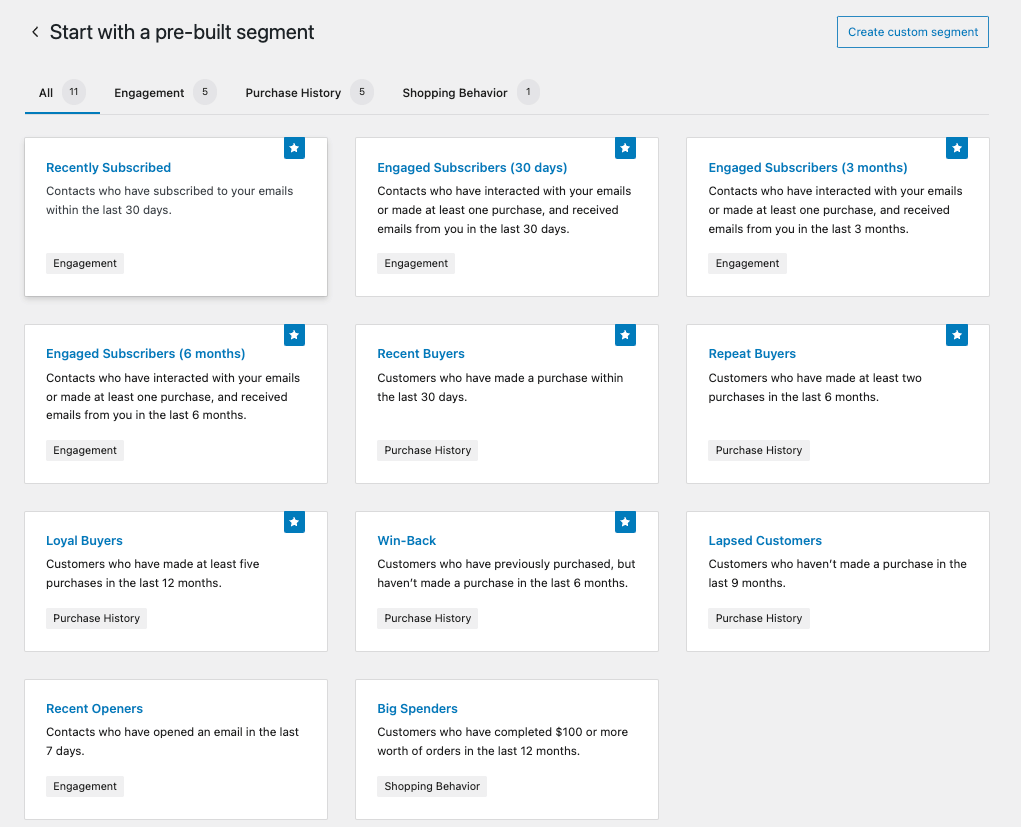
MailPoet segmentation
MailPoet offers 11 ready-to-go audience segments for immediate use. It divides the audience into segments based on the interaction with emails. You can also create more specialized segments by combining multiple segmentation options. This functionality is only available on paid plans. However, MailPoet doesn’t provide on-site behavior segments.
MailPoet segments include:
- Recently subscribed
- Engaged subscribers
- Recent buyers
- Repeat buyers
- Loyal buyers
- Win-back
- Lapsed customers
- Recent openers
- Big spenders
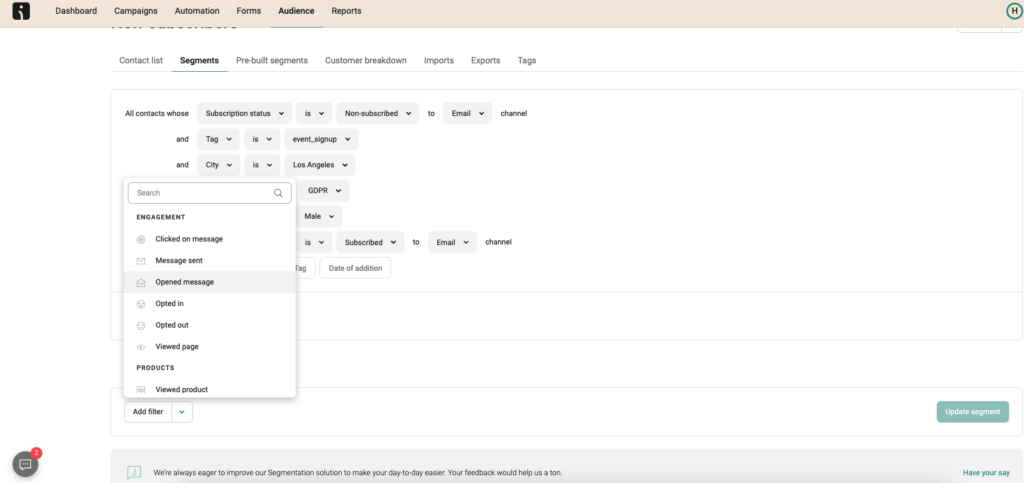
Omnisend segmentation
Meanwhile, Omnisend offers 30 ready-to-go segments. It also enables unlimited segmentation, regardless of the pricing plan.You can apply tags and multiple filters, like web tracking filters, to segment your audience.
All of Omnisend’s segmentation is based on the following six criteria:
- Channels
- Shopping behavior
- Email campaign activity
- SMS campaign activity
- Contact properties
- Web browsing activity
All in all, MailPoet needs to include segments based on on-site behavior, while Omnisend needs segment options that consider customer lifetime value.
Omnisend has an edge over MailPoet in segmentation. It offers more prebuilt segments with robust filtering functionalities to customize segment options.
Analytics
You can find an intuitive analytics dashboard on MailPoet and Omnisend to monitor your campaign performance.
MailPoet provides limited reports for newsletters after you have sent them. You can get standard email reports with insights into open rates, click-through rates, and subscriber engagement.
Other reports you can get on MailPoet include welcome email reports and WooCommerce reports, which Omnisend doesn’t provide. However, Omnisend provides advanced reporting and deliverability insights.
Unlike MailPoet, Omnisend provides a comprehensive sales and order report. It also provides a click map report for each campaign. The click map report lets you see where your subscribers click on your emails.
With Omnisend, you can get real-time analytics, which MailPoet lacks. On the downside, advanced reporting data older than 18 months is unavailable on Omnisend. Both platforms lack geo-location reports to view subscribers’ locations.
Omnisend leads in this round. It offers more analytics features to monitor and optimize your email campaigns.
Customer support
Quality customer support is fundamental to a good email marketing platform. Users on MailPoet’s free plan can send queries to the support team through the WordPress.org forums.

MailPoet provides a contact form where customers on paid plans can contact the premium support team. It also has a faster response rate. Users on this plan receive a response within 48 hours during business hours on weekdays.
MailPoet offers email support from Monday to Friday but lacks 24/7 live chat support.
Omnisend has you covered with 24/7 live chat and email support for customers. Users on the free plan can also enjoy this service. It sets a standard with an award-winning support team. It has an impressive median first response time of less than 3 minutes. There is also an online contact form for visitors to send their inquiries to the support team.
Video tutorials also provide comprehensive assistance on both platforms. However, Omnisend goes a step further by offering podcasts and topic-rich blogs.
Both MailPoet and Omnisend lack call support. Customers can’t request assistance via calls on either platform.
Omnisend outperforms MailPoet in customer support. It provides round-the-clock support, many support channels, and a short response time.
Integrations
MailPoet is a WordPress email plugin. It currently allows integration with WordPress and WooCommerce only. Meanwhile, Omnisend boasts seamless integrations with 130+ apps and platforms.
Here are a few of the platforms Omnisend allows for integration:
- Ecommerce platforms: WooCommerce, Shopify, Bigcommerce, Wix, etc.
- Signup form tools
- CRM tools
- Payment tools, etc.
Omnisend also provides a unique integration with Buy with Prime. MailPoet lacks this feature. This platform allows for a faster shopping and checkout experience.
Omnisend takes the lead with its extensive range of integrations.
Compatibility with other marketing channels
MailPoet doesn’t support SMS, push notifications, or Google Ads. This platform is only for emails.
With Omnisend, you can reach customers through ready-to-launch email and SMS marketing campaigns with all country codes supported. Also, you can integrate SMS, push notifications, and email as an omnichannel marketing communication flow.
Unlike MailPoet, Omnisend seamlessly integrates with popular marketing platforms like Facebook and Google Ads. It allows you to retarget customers who have abandoned their shopping carts.
Omnisend takes the win in this MailPoet vs Omnisend comparison because of its omnichannel marketing capabilities.
Generative AI tools
Email marketing is experiencing a growing application of AI for campaign creation and management. MailPoet has yet to adopt generative AI tools to handle email campaigns.
Meanwhile, Omnisend provides AI-powered features that assist in creating email campaigns. These features include:
- AI subject line generator
- AI text assistant
- AI product description generator
- AI-powered customer lifecycle segmentation
Omnisend leads in this round. Its generative AI features and dynamic content generation give it a competitive edge.
Price Comparison
This section is critical in this MailPoet vs Omnisend review. Here, we’ll compare both platforms’ pricing plans.
Free plans comparison
Let’s look at the features available on the MailPoet and Omnisend free plans:
- Send up to 500 emails per month to 250 contacts.
- 250+ professional email campaign templates
- Email A/B testing
- Pre-built workflows, and email, SMS, and push notifications automation
- Unlimited segmentation, including tags
- Signup form analytics, sales, and performance reports
- 24/7 live chat and email customer support
- 130+ Integrations
- Generative AI email tools
- Send up to 5,000 emails to 1,000 subscribers per month
- 50+ email templates
- Good email and form editors
- Welcome email and a few more automated emails
- Tags for segmentation
- Basic email engagement statistics
- Customer support through the WordPress forum
- WordPress and WooCommerce integration
You can send unlimited emails using Omnisend’s free plan. However, it is limited to only 250 contacts per month. Conversely, you can send emails to 1,000 subscribers each month on MailPoet’s free plan.
Paid plans comparison
MailPoet and Omnisend have tiered pricing options to accommodate different email marketing needs.
Let’s briefly discuss pricing. Here is a table highlighting MailPoet vs Omnisend paid plans
MailPoet and Omnisend offer unlimited emails on their paid plans. MailPoet’s Creator plan offers custom email sending along with the rest of the features of the Business plan.
MailPoet’s paid plans include various features such as detailed ecommerce analytics, WooCommerce sales statistics, Google Analytics integration, and advanced segmentation.
Omnisend’s paid plan also offers additional features not available on the free plan. These features include Omnisend branding removal and advanced reporting. The Standard and Pro plans also include a dedicated Customer Success Manager for $400 per month.
This MailPoet vs Omnisend pricing comparison reveals that MailPoet offers more affordable pricing.
Summary: Which one wins?
Both MailPoet and Omnisend have their perks and downsides. Before we disclose the ultimate winner, here’s a recap of MailPoet vs Omnisend features and pricing:
3.0
4.8
500 subscribers – $10
1,000 subscribers – $20
5,000 subscribers – $55
10,000 subscribers – $80
50,000 subscribers – $290
100,000 subscribers – $550
500,000 subscribers – $2000
500 contacts – $16
1,000 contacts – $20
5,000 contacts – $81
10,000 contacts – $132
50,000 contacts – $413
100,000 contacts – $900
150,000 contacts – $1456
- Send up to 5,000 emails to 1,000 subscribers per month.
- 50+ email templates
- Segmentation tags
- Newsletter scheduling
- Reach up to 250 contacts/month
- Send up to 500 emails/month; 500 web push notifications; 60 free SMS
- All features on Omnisend are available without any limitations, except from advanced reporting which is available on Pro plan only
- Easy to use
- Offers all necessary functions for beginners
- Affordable
- Good customer support
- Robust automation
- Advanced analytics
- Gamification in signup forms
- Unique coupon codes
- Modern-looking newsletters
- Email+SMS marketing
- Overly simplistic analytics
- No landing pages
- No generative AI assistance
- No live chat support
- Advanced features on Business plan only
- Doesn’t provide a geo-location report
- More expensive than MailPoet
- WordPress and WooCommerce users
- Bloggers
- Beginners and startups
- Woocommerce users
- Ecommerce stores of all sizes, both beginners and advanced users
- Established ecommerce businesses
- Established solopreneurs
- Solopreneurs
- Bloggers
- Governmental and non-governmental organizations
MailPoet vs Omnisend: which one’s the ultimate winner?
MailPoet is a solid choice for beginners and small businesses looking for a basic email marketing solution. It offers a clean interface with an easy way to get started. MailPoet also offers templates to create stunning email campaigns.
However, Omnisend’s ease of getting started, advanced automation, and personalization outperform it. It also excels in its multi-channel marketing capabilities and innovative AI tools. With all these features, Omnisend emerges as our overall winner in this MailPoet vs Omnisend review.
Read full reviews
Related picks for you
Our team strives to be accurate and unbiased in reviewing email tools. However, we recognize that mistakes can happen, and it’s essential for us to stay up to date. If you come across any errors or things that need to be reviewed again, please let us know.





Leave a Reply